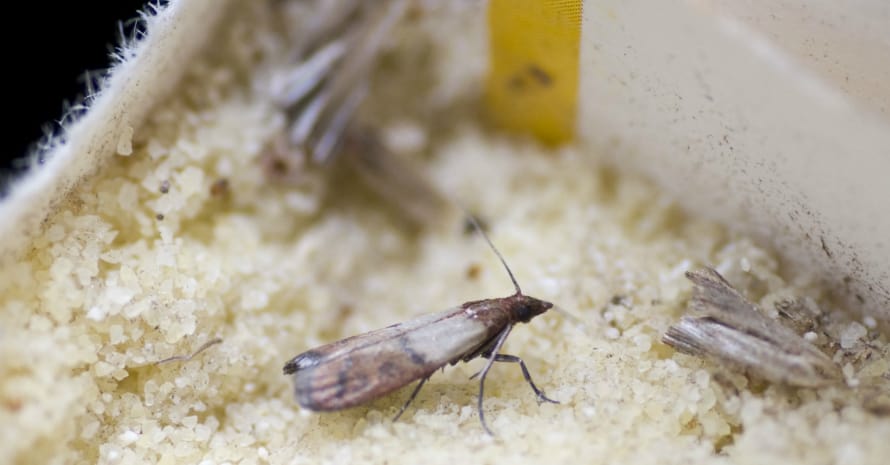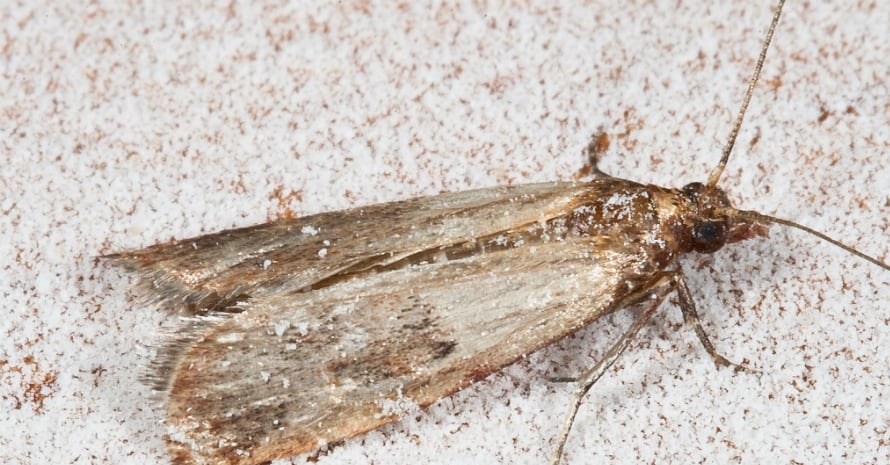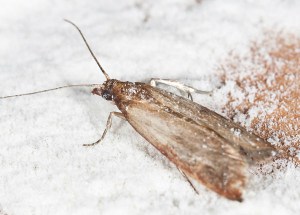Attracted to stored foods and fabrics, as well as grain and flour, pantry moths can become a regular occupant of your cupboard. These insects, sometimes called Indianmeal moths, are in love with dark, warm places. There, they can easily breed and dwell, populating dozens of insects monthly.
While they are known to cause little harm to humans and pets, knowing how to get rid of pantry moths should be a basic housekeeping skill. And today, I’d like to offer you a helping hand in fighting against the pests. Let’s see what’s the real deal with the critters!
Pantry Moths: Housemates You Didn’t Ask for
It’s a fact that a pantry moths infestation starts small and gradually grows into a disaster that is so hard to stop. The problem is caused by several common reasons, as well as the ignorance of people who simply don’t notice the forthcoming issue. To be well-prepared and act effectively, you need some moth pest control advice.

What are pantry moths?
It’s a kind of indoor insect that prefers dwelling in food-storing places, like cupboards, pantries, food, and grain storages. Normally, they are brown or grey-colored with long, paper-thin wings and pointy antennae. They use dry food as a nesting and feeding place since it provides them with warmth and moisture.
The pests are seen as a threat to food and fabrics because, as they breed and nest, their habitat is polluted with feces.
Though they live a relatively short time compared to other insects – up to 3 weeks, it’s enough for them to become a problem. During this period, each critter can lay around 50 eggs, which will hatch shortly after. They can become a major issue since getting rid of pantry moths is not that easy, considering such a tremendous population.
How do pantry moths appear in your house?
There are a couple of ways how moths can get to your house. First, a single insect can be attracted to your dwelling in search of shelter from bad weather or looking for a resting place. How to prevent pantry moths from getting into food? Use airtight containers or seal your flour, cereal, and grain packages.

Second, moth eggs and larvae can be transported with the food you buy. Cereals, grains, flour, etc. might have gotten contaminated while being produced. This way, the larvae are sealed during packaging and travel directly to your house. When you open a box of cereals or a packet of flour, the pests are awoken and begin their hunt for food and shelter.
How to get rid of pantry moths?
The best way to ensure the safety and hygiene of your kitchen and food closet is to know how to keep moths out of the pantry for good. For this you will need to follow the next steps:
Step 1: Identification
Finding out whether it’s the right kind of pest you’re dealing with is an important part of prevention. However, there can be other insects that, when identified, require immediate intervention (like clothes moth).
To distinguish a common pantry moth, look at the following:
- Coloring. Normally, moths are brown or a little greyish with some gleam on their wings. Sometimes, there can be a combination of the two, when the top part of the wings is pale grey with a dark brown wing bottom.
- Size. Their length is around ⅝ of an inch, and they rarely grow to be bigger. However, the female can be a little elongated as it carries around 50 eggs at a time.
- Larvae. Moth maggots are quite similar to other species’ larvae. However, they have a distinct paper-thin cover that sometimes causes them to look almost transparent.
Step 2: Inspection
One of the many signs that you have a pantry moth problem is webbing. Yes, they do produce webs but not made of silk or sticky glue. Their webs are nets of feces and biowastes produced during breeding and feeding. If you find them in a container, this should ring a bell for you.
Also, webs are followed by a rather disgusting stench. It’s also a product of their lifecycle, which you can encounter once a food-storing container is unsealed. The stench is another sign that your pantry moths’ eggs have hatched, and there is a load of maggots around.
Step 3: Treatment
There is an array of remedies and products for this issue. For instance, you can:
- Use natural alternatives to synthetic chemicals. Rosemary, lavender, eucalyptus, etc. are a proven natural pantry moth repellent. When placed in and around a cupboard, the extracts create a smell rather pleasant for humans but so alarming for moths. Also, you can smear containers and furniture with vinegar and lemon juice, which can kill the pests.
- Apply professional repellents. These substances are based on natural essences and oils that can be used both for prevention and treatment. Clean the containers with them and spray/smear them around the infested area. They are extremely safe and don’t harm people or animals.
- Place traps. By filling up your pantry with moth traps, you can prevent moths from spreading around and traveling to other food containers. Unwrap the packaging and fold it as instructed. It will attract the pests with a pleasant smell and strand it upon the first contact.
[amazon table=”12042″ tracking_id=”how-to-get-rid-of-pantry-moths-20″]
How to prevent moths in your house in the future?
- Scatter natural and professional essences around the house to deter the insects.
- Clean inside the cupboards regularly using water combined with cedar and vinegar.
- Check newly bought grain and cereal packages for eggs and maggots. In case you find some, get rid of the food immediately.
- Pay attention to old furniture and wardrobes, where moths can find shelter.
- Brush carpets and fabrics now and again to get moth eggs and adults out of it.
- Use airtight covers for storing clothes and food; also, separate them from one another by keeping each on a different hanger.
Top 5 Best Pantry Moths Treatments for Prevention and Maintenance
To take it off your shoulders, I’ve prepared a short Top of my favorite products and treatments that have immensely helped me before. Most of them are conventional repellents and sprays that are quite versatile, whereas others are meant for a specific use. Consider their pros and cons to determine the best way to get rid of pantry moths for your situation.
1. Dr. Killigan’s Premium Pantry Moth Traps — Best Moth Traps for Secluded Places
[amazon box=”B00U1SMPBS” template=”vertical” tracking_id=”how-to-get-rid-of-pantry-moths-20″ button_text=”Check price on Amazon”]
Specifications:
- Material: Paper and Glue
- Number of Pieces: 6
- Item Weight: 0.11 Pounds
- Product Dimensions: 5 x 4.5 x 4.5 inches
- Target Species: Moth

Known for their effectiveness and safety, these traps are a nice way to secure your furniture, attic, and basement from moths. They are easy to use and require little maintenance. Also, once installed, the traps will stay fresh and do their job regardless of the time exposed to the air.
Infused with pheromones, they easily attract moths at a considerable distance. The insects will find the product an alluring source of food, whereas they will be trapped upon coming in contact with them. As for the glue, it’s completely organic and contains no toxic elements. Therefore, it’s harmless to humans and pets, doesn’t irritate the airways, and does not make the air stuffy. By deploying the traps, you can change their location once an area is clear of the pests.
| Pros: | Cons: |
|
|
2. Wondercide Natural Products Indoor Pest Control Spray — Best Natural Repellent Spray for Indoors
[amazon box=”B0764VD7ZW” template=”vertical” tracking_id=”how-to-get-rid-of-pantry-moths-20″ button_text=”Check price on Amazon”]
Specifications:
- Active Ingredient: Cedarwood Oil 4.2%
- Coverage: 32 oz. bottle treats up to 400 sq.ft.
- Item Weight: 2.31 pounds
- Product Dimensions: 12.8 x 4.57 x 3.62 inches
- Target Species: Flies, Ants, Spiders, Roaches, Fleas, Bugs and other
This treatment is effective against a whole array of insects, including moths. When used properly, the spray protects against the pests and exterminates them over time. It’s completely organic, contains no toxins, and can be used around children.
You choose among different essences, like Cedar, Peppermint, Lemongrass, etc. When applied, it soaks through cracks and crevices, thus getting to the places, where eggs and maggots can be hiding. The substance has a reduced evaporation period, which allows it to stay on surfaces longer and be less susceptible to the heat. It’s a great, natural way to get rid of pantry moths without chemicals and toxins.
| Pros: | Cons: |
|
|
3. BASF Residual Insecticide Prescription Treatment — Professional Insecticide for Large-Scale Extermination
[amazon box=”B008YKG2IW” template=”vertical” tracking_id=”how-to-get-rid-of-pantry-moths-20″ button_text=”Check price on Amazon” button_detail=”https://shareasale.com/r.cfm?b=410159&u=2583381&m=43235&urllink=www%2Edomyown%2Ecom%2Fpt%2D221l%2Dresidual%2Daerosol%2D175%2Doz%2Dcan%2Dp%2D1391%2Ehtml&afftrack=how%20to%20get%20rid%20of%20pantry%20moths” button_detail_text=”Check price on DoMyOwn”]
Specifications:
- Active Ingredient: Lambda-Cyhalothrin 0.05%
- Item Volume: 17.5 fl. oz.
- Package Weight: 1.1 pounds
- Package Dimensions: 11.6 x 2.6 x 1.7 inches
- Target Species: Ants, Bed Bugs, Booklice, Boxelder Bugs, Carpenter Ants, Carpenter Bees, Centipedes, Clover Mites, Cluster Flies, Cockroaches, Crickets, Earwigs, Fire Ants, Millipedes, Scorpions, Silverfish, Spiders, Springtails, Above-Ground Termites, Ticks, Wood Infesting Borers and Beetles and Wood Wasps
If you have a full-blown infestation, and nothing organic seems to work, then consider this one. The spray is a highly effective insecticide that exterminates a whole range of pests, including ants, bugs, flees, etc. It’s normally meant for indoor use but it’s as efficient outside, around the house or premises.
The aerosol consists of Cehalothrin, which is useful against mites that have high-breeding speed. At first, it’s wet and watery, and, therefore, saturates well in wood, concrete, and fabrics. When dried out, the substance leaves residues that pose the main threat to pests by contaminating an infested area. The particles can be later spread by insects by sticking to their hair, which is perfect for large pantry moth extermination.
| Pros: | Cons: |
|
|
4. Armour Shell Lavender Sachet and Cedar Bags — Natural Pantry Moth Repellent
[amazon box=”B081NT6QWW” template=”vertical” tracking_id=”how-to-get-rid-of-pantry-moths-20″ button_text=”Check price on Amazon”]
Specifications:
- Eco-Friendly
- Includes: 20 sachet bags, 10 dried lavender flowers and 10 cedar
- Item Weight: 12.6 ounces
- Package Dimensions: 9.02 x 7.28 x 3.86 inches
- Target Species: Moth

Rather handy and well-made, these bags can be used as a prevention method for moths. Compact and portable, there is no limit to where the product can be placed. Also, they are infused with Lavender and Cedar essences for a pleasant smell.
There are 20 units in a single pack, where half of them are lavender and the other half is cedar. The number is sufficient for stuffing your clothes, shoes, furniture, and bedding. When placed there, the bags give off a faint scent of the herbs that moths find repulsive, which makes them flee and avoid the area. The product is completely organic and includes no harmful chemicals.
| Pros: | Cons: |
|
|
5. Green Gobbler 30% Pure Vinegar — Organic Pantry Moth Killer
[amazon box=”B00VVMTM14″ template=”vertical” tracking_id=”how-to-get-rid-of-pantry-moths-20″]
Since vinegar is what kills pantry moths for sure, there is no better alternative to this solution. It’s perfectly suitable for both indoor and outdoor use, as well as for household premises. Made of exclusively natural components, the product can be applied around vegetable patches and gardens.
Consisting of good-old vinegar, the product is a time-proven treatment against moths. Not only does the pest find it repulsive but it’s rather liable to poisoning once it inhales or costumes the substance. Just spread some of it around your infested area and leave it be for some time, the pests will stream out or get annihilated.
| Pros: | Cons: |
|
|
FAQs

Take a look at this section to find more answers to your questions!
What is the fastest way to get rid of pantry moths?
The most efficient way to deal with moths is to use a professional pantry moth killer. It includes a lot of the most unfavorable components that bring down your pests within minutes. However, if you’re dealing with fabrics and carpentry, try using natural remedies and essences and scatter them around the house. They can deter the insects, rather than kill them, though.
Can an exterminator get rid of pantry moths?
Of course, they can. These people are specifically trained to manage pest infestations of any scale. First, try to clear your house of moths using natural and professional solutions. If this doesn’t work out, invite a professional.
How long do pantry moths live?
When talking about adult insects, this breed can survive no longer than a month (around 3 weeks). However, they each lay up to 50 eggs before parishing, which spurs the swarming.

Don’t Let Pantry Moths Become Your Housemates
Yes, moths aren’t harmful to your health or well-being, unlike spiders, flees, and other pests. However, they contaminate everything, spoil food, and wreck your clothes. Knowing how to deter and how to kill pantry moths is a skill that will prove most useful in time.
Use oils and essences to prevent their breeding, apply sprays to clear the shelves and pantries of them, and use insecticides to avoid further contamination.
All in all, that’s it for today. I deem the information will come in handy to you one day or even now. What kind of treatments have you used before? Which is a better repellent: cedar or lavender? Leave your thoughts below!
References:
- Pantry Moths (National Pesticide Information Center):
http://npic.orst.edu/pest/pantrymoth.html - Pest Control Advice (Oxford City Council):
https://www.oxford.gov.uk/info/20100/pest_control_advice/139/pest_control_advice_-_moths - Natural alternatives to synthetic chemicals (Department of Primary Industries and Regional Development):
https://www.agric.wa.gov.au/mechanical-physical-and-cultural/natural-alternatives-synthetic-chemicals?page=0%2C2

